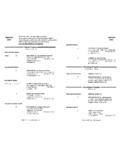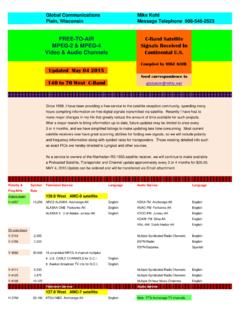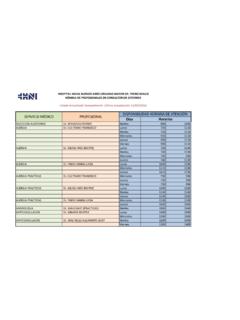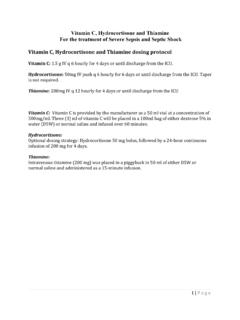Transcription of TRUCK TIRE TYPES AND ROAD CONTACT PRESSURES by …
1 TRUCK TIRE TYPES AND road CONTACT PRESSURES by Pedro Yap Senior Design Engineer The Goodyear Tire & Rubber Company A Paper Prepared for Presentation at the Second International Symposium on Heavy Vehicle Weights and Dimensions Kelowna, British Columbia June 1989 ABSTRACT Meeting the changing requirements of the trucking industry has resulted in the development of new tire concepts and sizes. The CONTACT PRESSURES developed at the interface of the tire and roadway are an important consideration in the TRUCK tire design/development process. Critical tire performance properties affecting the economics and safety of the TRUCK operation are impacted by the interaction between the tire and roadway. The magnitude and distribution of the tire CONTACT PRESSURES produced are a function of tire factors and various operational param-eters. Results of a laboratory study to determine the effect of the primary operational parameters of load and inflation on tire CONTACT PRESSURES are presented.
2 Key tire sizes are addressed. INTRODUCTION The economic and regulatory considerations facing the trucking industry impacts the direction of TRUCK tire development efforts. New tire concepts and tire sizes have been and are continuing to be developed to meet the changing trucking operational environment. The first step in the TRUCK tire development process involves identifying the tire performance properties required for the target application, examples of these performance properties are listed in TABLE 1 (1). The interaction between the TRUCK tire and the roadway is an important design consideration as it has a direct impact on the cost and safety of the TRUCK operation, in addition to being an issue relative to pavement life. PRIMARY TIRE PERFORMANCE PROPERTIES MECHANICAL ENDURANCE TIRE DYNAMICS DURABILITY TRACTION TREADWEAR NOISE BRUISE ROLLING RESISTANCE CUTTING, CRACKING, It TEARING TIRE CONTACT pressure Table 1 TRUCK Tire Performance Properties Many factors, both tire related and operations related will affect this tire/roadway interaction.
3 A laboratory study was conducted to measure vertical tire CONTACT PRESSURES to obtain a. better understanding of the influence of these factors (2). TIRE/ road CONTACT pressure CONTACT PRESSURES for this study were collected in the laboratory with the use of a specially instrumented flat bed machine, FIGURE 1. CONTACT data at selected tire loads/inflations were obtained by rolling the tire slowly over a strain gage imbedded in the flat bed. The bed also moves with the slow rolling tire, this enables the strain gage to collect data over the entire length of CONTACT , FIGURE 2. Lateral positions of the strain gage are also selected to characterize the behavior of each tread element across the CONTACT width. II~I ~~~i~S~:r';~~1~ /: :."-. Figure 1 Tire CONTACT pressure Test Machine 1'-'1 : .. : -"l~----------5E _u ___ _ ---A STRAIN GAGE LOCATION Figure 2 CONTACT pressure Measurement Path Tire load and velocity generate forces at the interface of the tire and roadway.
4 These forces act in two planes within this interface region, called the CONTACT area or footprint area. There is a vertical component acting in the "Z" direction, a longitudinal component acting in the "X" direction, and a lateral component acting in the "Y" direction, FIGURE 3. -T"""" LOAD Figure 3 Tire/ road CONTACT Force Component Directions Those in the lateral and longitudinal direction are termed "inplane" CONTACT forces. They result from the bending of the tire as it is deformed from its normally toroidal shape at the tire/ road interface. These inplane CONTACT forces are generally smaller in magnitude than those developed in the vertical direction. The lateral forces generated in the footprint tend to close the grooves of the tire. These forces (Fy) remain fairly constant through the majority of the CONTACT length, FIGURE 4. "Y" DIRECTION 20 ~ 15 VI ..0 w U a::: 10 ~ 5 I-U 0 I-Z o U -5 -10-t.
5 ---,--.,----,----,---,----r---r----, o 2 J 4 5 6 7 8 9 CONTACT LENGTH (IN.) Figure 4 Lateral CONTACT Forces The longitudinal forces are generally directed towards the center of the footprint. Normally there is a change in the direction of the longitudinal force (Fx) close to the midpoint of CONTACT length and at the exit region, FIGURE 5. 20 -;-15 (I) ..0 .::::,.. w U et: 10 e 5 I-U I-z o U -5 -10-t----,--,--,---,---, o 2 J 456 7 CONTACT LENGTH (IN.) 8 9 "X" DIRECTION Figure 5 Longitudinal CONTACT Forces There are three TYPES of tire/ road CONTACT PRESSURES : static, dynamic, and transient. The CONTACT PRESSURES addressed in this paper are quasi-dynamic because of the slow speed the test data was collected, .10 mph. Dynamic PRESSURES are more difficult to assess, measurement of these effects are beyond the test machine capabilities. Understanding the static interaction between the tire and roadway will provide a good foundation before addressing the dynamic interaction.
6 VERTICAL CONTACT PRESSURES This study focused on the PRESSURES exerted by the loaded tire in the vertical direction. Vertical CONTACT PRESSURES are generally non-uniform over both the width and length of CONTACT , FIGURE 6. Peak vertical CONTACT PRESSURES are achieved in the central region of the CONTACT area. The shape of the longitudinal pressure curve is dependent on its lateral position across the CONTACT width, illustrated in FIGURE 7. The shoulder region pressure curve in this example exhibits a gradual rise and fall of CONTACT PRESSURES , the center region pressure curve exhibits a . more rapid increase of pressure at the entry region of CONTACT , a plateau at the midsection, and a rapid decrease at the exit region. w a: ::l Vl Vl W a: Cl. I-U cc I-Z o U ..J cc u. ~~IIIII~ Figure 6 vertical Tire CONTACT pressure iiiij+---SHOULDER REGION ~ --CENTER REGION DIRECTION OF TRAVEL UJ a: :::l Cl) Cl) UJ a: 0.
7 / CENTER REGION ~----~ t; -' .. ~, " z, , o / , u /, , ~ I "SHOULDER REGION \ U I \ ~ I \ UJ I \ > I \ CONTACT LENGTH Figure 7 CONTACT PRESSURES Along CONTACT Length Vertical CONTACT PRESSURES are a function of tire factors and operational factors. It is these factors which determine how the tire distributes CONTACT PRESSURES across its tread width and the peak CONTACT pressure achieved,FIGURE 8. Any number of PRESSURES distributions across the CONTACT width are possible, depending on the tire's state of loading and its particular tire construction, FIGURE 9 (3). This is the reason why for the same tire size, CONTACT pressure distributions may differ from tire manufacturer to manufacturer and even within the same manufacturer. 250 100 Figure-8 vertical CONTACT pressure Distribution Radial TYPE 'A' 11R24_~ ' " 5640 LaS. LOAD 9!5 PSI IN"IJ. TION Radial TYPE '8' -------Figure 9 Typical Radial Tire CONTACT pressure Distributions Radial TYPE 'C' -Tire Factors Affecting CONTACT PRESSURES Tire construction and tire design are the two key tire factors which influence how a TRUCK tire distributes vertical CONTACT PRESSURES and the peak level achieved, FIGURE 10.
8 Tire construction consists of the materials and their orientation within both the crown and carcass structure of-the TRUCK tire. Tire design consists of parameters such as tire shape, tread pattern, and tire dimensions. I TIRE CONSTRUCTION I ---------CROWN STRUCTURE ~--CARCASS STRUCTURE I TIRE D@@RJ TIRE SHAPE TREAD PATTERN TIRE DIMENSIONS Figure 10 Tire Factors Affecting CONTACT pressure One of the major developments in terms of tire construction has been the radial-ply TRUCK tire. Since its introduction during the late 1960's the radial-ply TRUCK tire has continued-to increase its market share over its predecessor, the bias-ply TRUCK tire, FIGURE 11. It offers improved tread life in addition to improved fuel economy. The bias-ply TRUCK tire has a fairly stiff carcass structure, due to it multiple cross-angled' fabric body plies. The crown structure has multiple cross-angled fabric breakers in addition to the fabric body plies.
9 The radial-ply TRUCK tire on the other hand has a fairly soft carcass structure but a relatively stiff crown structure. This is a result of the carcass construction having a single radially oriented steel body ply. The crown structure is constructed of multiple angled steel belts. These construction differences result in a marked difference in the way the two tires respond to load. The softer carcass structure of the radial-ply tire produces a greater amount of vertical deflection, FIGURE 12. This is also an indication of the damping characteristics of the tire. I BIAS-PL Y I I RADIAL-PLY I Figure 11 TRUCK Tire Constructions ? u z o ~ -l Cl 0::: i= ~\,~.~ ~~ ~\~\, ~t>: _ 95 ~S\) _ S {\~f\..~ --: '6\~ : .. !'=--r----,.---, ~-.,____, o 1000 2000 3000 4000 5000 TIRE LOAD (Ibs,) 6000 7000 BOOO Figure 12 Tire Deflection Versus Tire Load Maximum vertical CONTACT pressure of these two tire TYPES at their typical steer and drive/trailer axle loads/inflations are.}
10 Shown in FIGURE 13. The bias-ply tire generates lower peak PRESSURES than the radial-ply tire, in the order of about -12% less at the steer tire load and about 26% at the drive/trailer loads. Average CONTACT PRESSURES at these same loading condi~ tions are about equal to inflation pressure , the bias-ply tire still is less than the radial-ply tire, FIGURE 14. 250 "'"'"' 'in 5200 e:::: ::::> V11 V1 e:::: 1-1 u I-z o u INFL: o STEER DRIVE/TRAILER BIAS RADIAL BIAS RADIAL 95 psi 100 psi 100 psi 105 psi Figure 13 Max~ Vertical CONTACT pressure e:::: ::::> V11 V1 e:::: 1-1 U I-z o u INFL: STEER DRIVE/TRAILER BIAS RADIAL BIAS RADIAL 95 psi 100 psi 100 psi 105 psi Figure 14 Average Vertical CONTACT pressure The second of the two tire factors affecting CONTACT pressure is tire design. Three tire parameters fall within this category: tire shape, tread pattern, and tire size.










